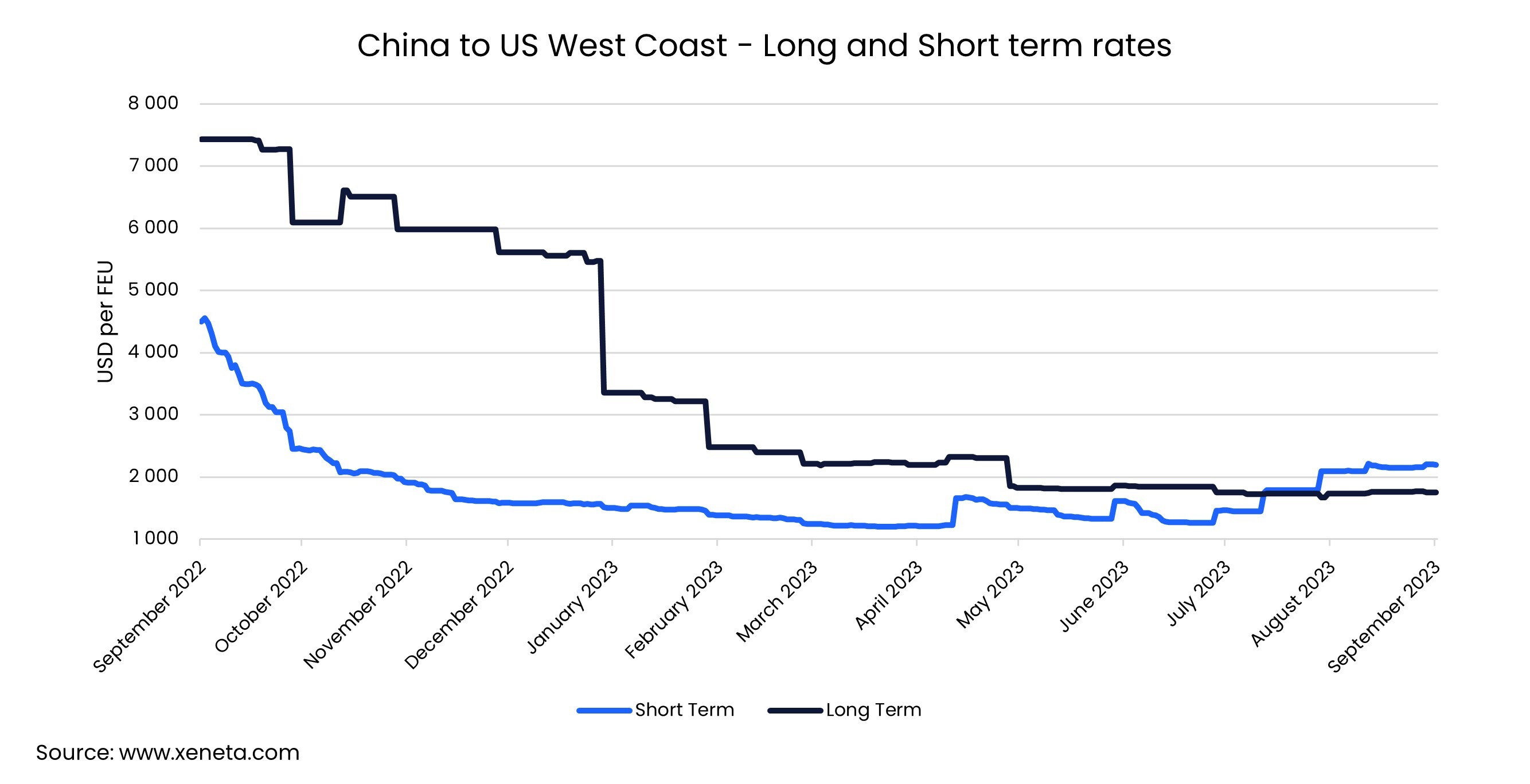Capacity management is king. Container shipping carriers know this better than anyone. And while getting it 100% right is nigh on impossible, carriers have shown that they do have the ability to read the market – and change the game in their favor – with smart strategic moves. The latest developments on the key Asia to North America West Coast corridor provide a powerful case in point.
A nasty surprise?
Rates on this trans-Pacific trade lane have rocketed since the end of June, as carriers double down on capacity cuts and, in effect, outsmart shippers who have been biding time to see how uncertain US consumer demand evolves.
Xeneta’s data for the China to US WC trade lane shows that spot rates in early September are up by 73% from end-June, reaching USD 2,200 per FEU, an 11-month-high. Moreover, carriers have successfully lifted rates for long-term contracts too, delivering a nasty surprise for shippers that may have waited too long in putting pen to paper. Freight rates for long-term contracts entering validity in August now exceed USD 2,000 per FEU, 25% up from the lows of June.
So, how have they engineered this rates revival?
When in trouble, double
In the second quarter of 2023, carriers collectively reduced their offered capacity from Asia to the North America West Coast by 7% when compared to the same period last year. Despite this move, the General Rate Increases (GRIs) implemented in mid-April and early-June failed to stick.
Their response? More of the same.
In July and August, carriers again united to reduce their offered capacity by 14% year-on-year. The impact of that, as we can see, was very different, with shippers wary of that uncertain consumer demand forced to bite the bullet.
Gold rush?
The timing of this development has added significance as China’s Golden Week appears on the horizon. This major public holiday, beginning on 1 October, has the potential to exert a major impact on the trans-Pacific trade.
In ‘normal’ years, carriers increase their offered capacity in the run-up to Golden Week to meet higher demand, followed by an expected slowdown and blanked sailings.
But, as readers will be well aware, 2023 is no normal year. As such, diligent capacity management will be front of mind with carriers as they look to retain the positive spot rates development. And what is the best way to defend the spot rates when overcapacity comes creeping in?
Lost opportunity?
Blanked sailings have already been announced for the rest of September and into October, mainly for weeks 39 and 41 - namely one week before and one week after the Chinese holiday, according to data from Sea-Intelligence. In week 41, carriers have currently confirmed nine blank sailings (amounting to 75 448 TEU), but more are expected, both for that week and others.
Carriers have managed to reduce capacity and achieve desired rates results in recent months, in part by adopting a united front. However, looking ahead it only takes one carrier to deviate from this course to bring rates back down. But breaking ranks at present doesn’t appear to be a strategy any carrier is favoring, meaning spot and contract rates are likely to continue trending upwards in September.
Shippers need to be on their toes to assess the upside and downside supply chain and logistics risks associated with China’s upcoming holiday. A failure in this regard could translate into millions of dollars in higher logistics costs – money that would have looked much better on their own bottom lines.
Looking at the market now we have to ask: Have shippers lost out on the opportunity to strike at the right time? Or will they get a second chance? Time, and Xeneta’s data, will tell.
Want to learn more?
Contact us to learn how Xeneta can help you prepare for this upcoming tender season and supplier/buyer negotiations. Gain the upper hand with actionable real-time ocean and air freight rate and capacity data.





